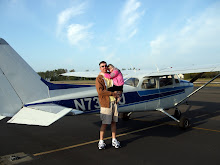
This photo is Sportsman Airpark (Newburg OR)from about 2500ft AGL.
Lesson 31 – 1.5hrs stalls, steep turns, and simulated engine out.
Sunny skies with no wind! Nice for flying, but not much help for practicing the ground referance maneuvers I need work on, so we departed Twin Oaks and headed for the practice area for some work on steep turns, and stall review.
We overflew Sportsman Airpark at 3000ft, and began a simulated engine out. I was a bit worried about losing too much altitude, resulting not losing enough, and made the mistake of diving to correct. Diving for the runway did lose some altitude, but also put me at least 10kts fast. After half the runway had gone underneath without us touching it, I had to go around.
My instructor demonstrated the next, and rolled out on final high to demonstrate how a slip would have been a better choice.
We took off again so I could take another shot at it, managing my descent better, and touching down just past the numbers with 10 degrees of flaps.
Simulated engine out landings are all about energy management. You can slow down (to a point) and gain a little altitude, or at least slow your descent. You can lose altitude by pushing the nose down, but then you increase the airspeed making it difficult to slow down again to land. Or, you can increase drag using flaps and/or a slip to lose altitude without gaining airspeed. In the end, you can't slow the loss of altitude without a loss of airspeed, or increase airspeed without a loss of altitude, so it's a balancing act (art).
After each landing I’d practice a simulated short of soft field take off. My short field takeoffs have been good for a while, the soft field I’ve had trouble holding it in ground effect. This lesson I seemed to get the hang of it (a minor victory, but I’ll take it).
Power-on and power-off stalls were good, steep turns still need some work but are getting better, and turns around a point were easy with no wind.
We also covered emergency descents, and I’m pretty sure a 60 degree bank angle turn with a 2000 fpm descent will always be a rush.
A good simulated short field landing back at Twin Oaks was a nice end to lesson that really highlights some areas that need work.
Sunny skies with no wind! Nice for flying, but not much help for practicing the ground referance maneuvers I need work on, so we departed Twin Oaks and headed for the practice area for some work on steep turns, and stall review.
We overflew Sportsman Airpark at 3000ft, and began a simulated engine out. I was a bit worried about losing too much altitude, resulting not losing enough, and made the mistake of diving to correct. Diving for the runway did lose some altitude, but also put me at least 10kts fast. After half the runway had gone underneath without us touching it, I had to go around.
My instructor demonstrated the next, and rolled out on final high to demonstrate how a slip would have been a better choice.
We took off again so I could take another shot at it, managing my descent better, and touching down just past the numbers with 10 degrees of flaps.
Simulated engine out landings are all about energy management. You can slow down (to a point) and gain a little altitude, or at least slow your descent. You can lose altitude by pushing the nose down, but then you increase the airspeed making it difficult to slow down again to land. Or, you can increase drag using flaps and/or a slip to lose altitude without gaining airspeed. In the end, you can't slow the loss of altitude without a loss of airspeed, or increase airspeed without a loss of altitude, so it's a balancing act (art).
After each landing I’d practice a simulated short of soft field take off. My short field takeoffs have been good for a while, the soft field I’ve had trouble holding it in ground effect. This lesson I seemed to get the hang of it (a minor victory, but I’ll take it).
Power-on and power-off stalls were good, steep turns still need some work but are getting better, and turns around a point were easy with no wind.
We also covered emergency descents, and I’m pretty sure a 60 degree bank angle turn with a 2000 fpm descent will always be a rush.
A good simulated short field landing back at Twin Oaks was a nice end to lesson that really highlights some areas that need work.

No comments:
Post a Comment